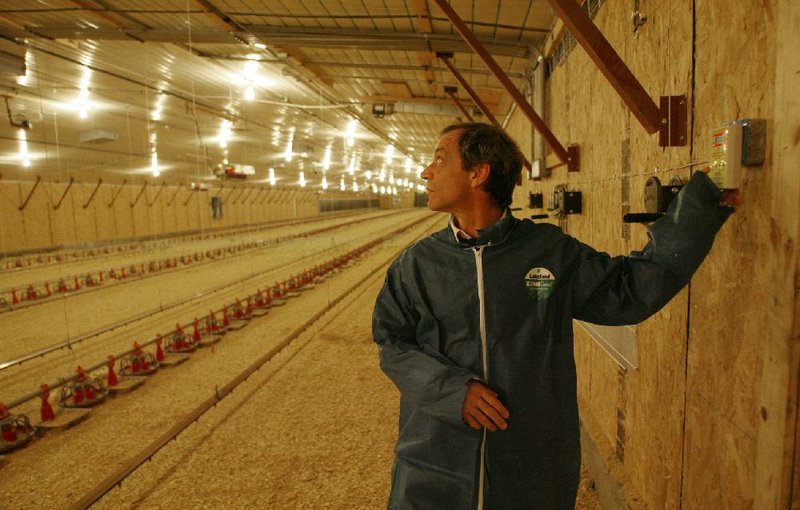LITTLE ROCK — Savings shine for poultry houses with LED lights
LAURIE WHALEN
ARKANSAS DEMOCRAT-GAZETTE
Salesmen at NextGen Illumination Inc. of Fayetteville are pounding the pavement to increase demand for a lighting product promising big savings for chicken farms.
The startup is one of four lighting technology suppliers with products subsidized through a $1.2 million rebate program administered by the Arkansas Economic Development Commission.
As a result, poultry farmers across the state are able to halve the price of energyefficient lights with American Recovery and Reinvestment Act funds if they agree to switch out a house lit by incandescent bulbs.
“In three months I’ve put almost 12,000 miles on my car,” said Jeffrey A. Beaver, vice president of research development and partner in NextGen Illumination Inc., which designs and sells lighting for interior and exterior applications.
The state’s estimated 2,400 “broiler” farmers, however, have been a hard sell, he added. Broiler farm- ers produce chicken for integrators such as Tyson Foods Inc. of Springdale or Pilgrim’s Pride Inc. of Greeley, Colo., and integrators approve the equipment used in houses owned by contract poultry farmers.
Farmers, in general, are “frugal and resistant to change,” and they’ve needed something to help them switch from incandescent bulbs, said Beaver, whose company specializes in designing light-emitting diode, or LED, technology.
A light-emitting diode is a semiconductor chip that converts electricity into light. LEDs are touted for their durability and energy efficiency, despite the technology’s high cost.
A farmer who converts to an LED from an incandescent bulb can make his money back in less than a year, said Scot Hundley, director of operations at Luma Vue, an LED design firm in Rogers, which is the only other Arkansas-based vendor participating in the rebate program.
To date, the Arkansas Poultry Lighting Rebate Program has processed rebates for 118 farmers.
Rebated purchases have ranged from as few as 52 bulbs, enough to light one house, to as many as 1,536 bulbs, according to the AEDC.
The University of Arkansas Division of Agriculture launched its own LED bulb research effort in 2009.
Additionally, the UA continues a demonstration project that started in February 2010. Three bulb vendors participated in that study, including NextGen and Luma Vue. Federal stimulus dollars were used to provide bulbs distributed among 10 farms. The Energy Grant Phase 1 report is available online at the UA’s poultry science department website.
The demonstration project ends Dec. 31, and “at least two of the LED technologies demonstrated on poultry farms in this project are proving energy efficient as well as conducive to supporting optimum bird performance,” according to the report. Each poultry house requires between 50 and 150 bulbs. Lighting accounts for about a quarter of a poultry house’s energy consumption and is a yearround expense.
INFIELD TESTS
Beaver said the project’s results can help salesmen better counter resistance to a pitch as being “just snake oil,” he said.
The “stimulus money for us incentivized [bulb sales], by cutting the cost” of the bulb in half, Beaver said. “While that does have a significant impact, I think more than anything, going through the [field] demonstration, getting testing and validation in the field, before it [the bulb] rolled out, established a credibility in the market.”
Now, “I’m not just a guy that’s trying to sell a bunch of lights,” he said.
Susan R. Watkins, an associate professor in the poultry science department, said once farmers “see people doing well with it,” adoption of LED lights might come easier.
She noted that initial LED testing took place among large-scale operators, or those who can afford a $36 bulb.
That’s “a signif icant amount of money for folks operating on a tight budget,” Watkins said recently.
Some farmers have had to pay more attention to their finances since the poultry industry this year began correcting a glut of supply on the market. Not only have fewer eggs been placed for hatching, but companies also stretched the time between flocks.
A farmer used to waiting as few as eight days can now expect to wait as long as a month until the next delivery.
BUDGETARY CONCERNS
Farmers are having to “manage their budget to make the best decisions,” Watkins said.
In comparison with LED bulbs, incandescent bulbs can cost as little as 50 cents per bulb with poultry house wattage demands ranging from 40 to 100 watts. Traditional bulbs also produce more heat than light and typically have a shorter life span — 750 to 1,500 hours for a 40-watt bulb, for example.
Still other LED alternatives, such as compact fluorescent and cold cathode bulbs, are less expensive at $8 to $11 a bulb. They also come with a lower wattage or direct energy demand.
But the compact fluorescent has difficulty dimming, and cold cathodes lose brightness as they age, LED advocates say. Both pass electricity through a gas that emits a visible light and have an estimated 8,000-to-12,000-hour life span.
Hundley, director of operations at Luma Vue, said the firm’s LED product was a better buy since the LED bulb lasted longer than either a compact fluorescent or cold cathode bulb.
He noted that some of his growers had had no failures for three years.
The state’s Poultry Lighting Rebate Program offers a three-year warranty on any bulb.
Both funds and the push for incandescent alternatives has come in part from the White House.
The Energy Independence and Security Act of 2007 mandated that bulbs producing 100 watts worth of light meet certain efficiency goals, starting in 2012. The same rule will apply to remaining bulbs 40 watts and higher in 2014, The Associated Press reported.
Business, Pages 63 on 12/11/2011
